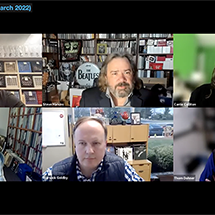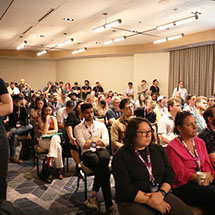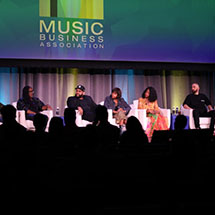
[Keeping Tempo With Music Biz] Exploring the Evolution of the Music Publishing Landscape: Op-Ed By DataArt’s Sergey Bludov

Although the COVID-19 pandemic continues, the light at the end of the tunnel is brightening as vaccines are rolled out to a growing number of global citizens. But once the dust has settled, what state will the music publishing industry be in, and how long will it take for publishing revenue and the overall marketplace to get back on track?
According to projections by the International Confederation of Societies of Authors and Composers (CISAC), the pandemic caused global music publishing revenue to decline by 35% in 2020 for a total loss of $4.78 billion. Fortunately, the US publishing market was experiencing exceptional gains for several years prior to the pandemic. According to statistics provided by the NMPA, annual US music publishing revenue reached $3.3 billion in 2018, marking an impressive 11.78% year-over-year increase. These numbers arrived as wonderful news to the publishing industry following several years of concern, with the truly remarkable growth resulting in a revenue increase of over one billion dollars from 2014 to 2018.
While this outstanding rise doesn’t erase the losses experienced in 2020, it does illustrate the prosperous state of the publishing market in the years leading up to the pandemic. Considering this remarkably positive trend, combined with innovative initiatives on the horizon, I’m confident that publishing revenue will be booming again in the very near future. Let us examine the music publishing landscape in detail and try to decipher what we can expect in the future.
Acquisitions and Consolidation
The pre-pandemic growth in the music publishing market was the catalyst for a wave of mergers and acquisitions, as the industry continues to consolidate in its ongoing evolution.
Concord Bicycle Music’s buyout of Imagem in 2017 marked one of the largest acquisitions in the history of the music business. Sources disclosed the purchase price as approximately $500 million, which equals an astounding 10-12 multiple of Imagem’s Net Publisher Share (NPS). The deal involves over 250,000 copyrights, including songs by Daft Punk and Phil Collins, and certainly makes Concord a major international player in the music publishing market.
Another notable acquisition came in 2018 with Round Hill’s $240 million purchase of Carlin Music Publishing. Reports indicated a heated bidding war over the catalog, which features iconic songs by Elvis Presley, AC/DC, James Brown, and many other legendary artists.
The list of significant publishing acquisitions in recent years is lengthy, with another example being the $160 million purchase of SONGS Music Publishing by Kobalt Capital. With exclusive publishing rights for a bundle of hitmakers, including The Weeknd and Lorde, the deal is yet another sign of the prosperous wave running throughout the music publishing industry.
The Vitality of Diversification
Diversification is paramount for expansion and continued vitality as the music industry ecosystem evolves. The growth of streaming is driving the changes, rising from 27% of publisher revenue in 2018 to an expected 50% by 2026.
Significant business moves made by Downtown Music Holdings clearly illustrate the industry shift. The parent company of Downtown Music Publishing and Songtrust acquired distribution and music/tech services company FUGA to expand its resources, infrastructure, and global scale. This deal closely followed Downtown’s purchase of AVL Digital Group, which included the subsidiaries CD Baby, AdRev, Soundrop, and DashGo.
Another sign of the diversification trend is found in a deal made by Schubert Music Europe—the holding company of Schubert Music Publishing—with Sony’s independent label distribution division, The Orchard. The agreement positions Schubert to distribute ten new record labels, thereby expanding the company’s publishing efforts into the business of recordings.
Overcoming Immediate Obstacles
With live music and other revenue streams were on hold during the pandemic, a large number of royalty collection/distribution societies made moves to help songwriters and owners.
One example comes from IMRO in Ireland with its decision to change the payout of radio royalties to monthly distribution to fill in the earnings gap resulting from the global health crisis. Other collection societies are providing royalty advances to soften the financial burden, such as SOCAN in Canada, with $2 million of emergency royalty advances being paid out based on the recent earnings of music owners. And in the United States, a wide range of music industry organizations and bodies created the Covid Relief Fund to help musicians and other copyright owners navigate any difficulties experienced in receiving funds from the government’s CARES Act.
Modernizing Licensing and Royalty Management
Although many challenges exist in cementing fair legalities around technologies that have gained prevalence in the music industry, such as virtual concerts and streaming, the Music Modernization Act (MMA) provides an excellent start. A large majority of the industry recognizes the need for massive changes in the way licensing and royalties are managed. Initially passed into law in 2018, the MMA is poised to more accurately reflect the realities of today’s industry, which has changed dramatically since some of the archaic music usage reporting laws were developed.
Before the MMA was passed by Congress, many digital music service providers (DMPs), including Spotify and Apple Music, exploited a loophole in US Copyright Law which allowed them to skip entering into direct licenses with song owners before playing their music. As a result, DMPs were able to avoid copyright infringement claims by unknown songwriters who came forward at a later date. Unfortunately, many song owners were not paid for the usage of their music because of this loophole.
To remedy this situation, the MMA established the Mechanical Licensing Collective (MLC) to administer blanket licenses for DMPs. The MLC will collect digital audio mechanical royalties from DMPs and distribute these earnings to song owners. The MLC was launched at the beginning of 2021, offering great hope as a solution to long-standing concerns about the lack of comprehensive royalty payouts in the digital audio realm.
Although the pandemic has increased the difficulty of moving forward in many aspects of the music industry, the MMA, and now the MLC, have managed to continue evolving over the past two years to create a climate of improved fairness for music owners. The MLC’s CEO, Kris Ahrend, succinctly summed up the need for licensing and royalty collection/distribution changes in a webinar last November, saying: “We live in a global world where music does not remain within boundaries”.
Unifying Technological Offerings
Another dramatic move in the publishing sector is the recent launch of Songview, which brings together the data from ASCAP and BMI into a one-stop platform to provide easier search and management capabilities. In the past, there were many difficulties involved in accessing songwriter information. For one, songs credited to multiple writers can require gathering data from several different PROs (Performing Rights Organizations), as this information was maintained separately. Songview was created to lessen this burden significantly by bringing the data from ASCAP and BMI into a single platform, which has never been done before now.
The successful creation of Songview is an extremely exciting development in the music industry. Although the need for a single point of works registration has been acknowledged for a long time, previous attempts have failed. One example occurred in 2014 when the hope of a solution arising from the Global Repertoire Database project came to a screeching halt. At the time, sources said the initiative had been “scrapped due to a fall-out of collection societies over funding,” leaving the industry to continue working towards a solution to this long-standing problem. While combining data is a highly complex undertaking, Songview proves the potential for success in this realm, providing great hope for improved efficiency and accuracy in the long term.
Conclusion
The music business may never be quite the same as it used to be, even once the pandemic is over. But we must remember that change is often positive. In the case of music publishing, I believe that the reexamination of our industry practices was long overdue, while the shifting landscape is creating an exciting wave across the entire music industry. I expect this shift to continue strongly, as companies take advantage of the flourishing market to expand into full-stack entities, with the potential to successfully handle publishing, recording, management, and more, all under one roof.
By: Sergey Bludov
SVP, Media & Entertainment, DataArt
You can read past “Keeping Tempo” articles via the portal linked here. And, stay tuned for more insightful discussions from our members and industry partners!












